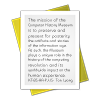Title
Gossett, Phil oral historyCatalog Number
102781588Type
DocumentDescription
Engineer Phil Gossett originally wanted to be a physicist, but as others have, got interested in computing at MIT and financial limitations pushed him to graduate in 3 years. He then moved to the West Coast in 1978 and began a long career building products, many of which might fall under the umbrella of digital media..He joined the Motion Pictures Group of Information International, Incorporated, in Culver City near Los Angeles, building a digital film printer and doing computer graphics for the movie Tron. (1982). He thought that was great fun. The company used a Foonly F-1 computer, a wire-wrapped, discrete ECL clone of the Digital Equipment PDP-10 and a challenging part of his job was keeping it alive.
However, that experience gave him contact with Foonly and its President Dave Poole offered him a Silicon Valley job, where he designed graphics equipment and designed various Foonly CPUs.
Foonly ran into financial trouble, got acquired by Tymeshare and then McDonald Douglas, and ended up working at Stanford’s Center for Computer Research and Music and Acoustics.
Digital audio needed accurate sample rate conversion, but existing methods were very expensive. He and Julius O. Smith designed a much more efficient method, described in “A flexible sampling-rate conversion method” (1984), which immediately got widely used in sampling synthesizers. Phil said that was his most successful product ever.
After a brief stint at MIPS Computer Systems designing a floating point board, he worked for Hurtmut Esslinger, founder of Frogdesign, doing digital video chips for a home entertainment system, FROX, but that project didn’t last.
Following work on digital video hardware consulting, he got hired by Silicon Graphics design a key part of the Nintendo 64 video game console, an extremely successful product launched in 1996. He architected much of the Reality Display Processor (RDP) side of the Reality Coprocessor, which handled all the graphics and audio processing, people wanted many of the features of the very high-end SGI Reality Engine. That was very challenging and required many clever tricks to offer reasonable 3D graphics using a single low-cost chip.
After SGI’s graphics business shrank, Phil started a company to work on advanced antennas for cellular radio, gave a talk whose audience included Larry Page and ended up at Google.
They created some interesting MIMO.(multiple-input and multiple-output) antennas that worked, but were never released, given changes in the business environment.
Phil’s experience ranged from tiny startups through large companies. As often happens, some projects worked, but did not succeed financially. However, he said he had 3 real winners.
First, the digital film printer was used for Tron, many other movies and TV shows from 1970s until early 1990s. Second, “"The Flexible Sampling-Rate Conversion Method” was very influential and was used pervasively. Third, the Nintendo 64 was a very successful product by any metric, including the unbeatable satisfaction of seeing kids in Fry’s thrilled with demos.
Date
2019-06-17Contributor
| Gossett, Phil, Interviewee |
| Mashey, John, Interviewer |
Publisher
Computer History MuseumPlace of Publication
Mountain View, CAExtent
34 p.Format
PDFCategory
TranscriptionSubject
Information international, Inc.; Foonly; Stanford Center for Computer Research and Music nad Acoustic; MIPS Computer; Silicon Graphics; Nintendo 64; Reality Display Processor; GoogleCollection Title
CHM Oral History CollectionCredit
Computer History MuseumLot Number
X9077.2019Related Records
| 102781589 | Gossett, Phil oral history |


